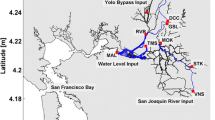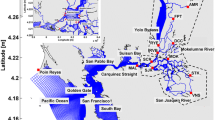Abstract
This paper deals with the mathematical modelling of confinement of paralic ecosystems. It is based on the recent paper (Frénod and Goubert in Ecol. Model. 200(1–2):139–148, 2007) that presents a modelling procedure in order to compute the confinement field of a lagoon.
Here, we improve the existing model in order to account for tide oscillations in any kind of geometry such as non-rectangular lagoons with a non-flat bottom. The new model, that relies on PDEs rather than ODEs, is then implemented thanks to the finite element method. Numerical results confirm the feasibility of confinement studies thanks to the introduced model.









Similar content being viewed by others
Notes
More realistic numerical choices (such as a Poiseuille profile) have been done, but do not influence the solution properties.
For the sake of clarity, the corresponding computations are detailed in the Appendix.
References
Angot, P., Bruneau, C.H., Fabrie, P.: A penalization method to take into account obstacles in incompressible viscous flows. Numer. Math. 81(4), 497–520 (1999)
Barnes: A critical appraisal of the application of Guélorget and Pertuisot’s concept of the paralic ecosystem and confinement to macrotidal Europe. Estuar. Coast. Shelf Sci. 38, 41–48 (1994)
Debenay, J.-P., Perthuisot, J.-P., Colleuil, B.: Expression numérique du confinement par les peuplements de foraminifères. app. aux domaines paral. actuels afri. w. C. R. Acad. Sci., Paris, série II 316(2), 1823–1830 (1993)
Frénod, E., Goubert, E.: A first step towards modelling confinement of paralic ecosystems. Ecol. Model. 200(1–2), 139–148 (2007)
Guélorget, O., Frisoni, G.F., Perthuisot, J.-P.: La zonation biologique des milieux lagunaires : définition d’une échelle de confinement dans le domaine paralique méditérranéen. J. Rech. Océanogr. 8, 15–36 (1983)
Guélorget, O., Gaujous, D., Louis, M., Perthuisot, J.-P.: Macrobenthofauna of lagoons in guadaloupean mangroves (lesser antilles): role and expression of confinement. J. Coast. Res. 6, 611–626 (1990)
Guélorget, O., Perthuisot, J.-P.: Le confinement, paramètre essentiel de la dynamique biologique du domaine paralique. Sci. Géol., Bull. 14, 25–34 (1983)
Guélorget, O., Perthuisot, J.-P.: Le domaine paralique. Expressions géologiques biologique, et économique du confinement. Presse de l’école normale supérieure 16-1983, 45 rue d’Ulm, Paris, 1983
Hecht, F., Pironneau, O., Le Hyaric, A.: FreeFem++ manual. (2004)
Ibrahim, A., Guélorget, O., Frisoni, G.G., Rouchy, J.M., Martin, A., Perthuisot, J.-P.: Expressions hydrochimiques, biologiques et sédimentologiques des gradients de confinement dans la lagune de Guemsah (Golfe de Suez, Egypte). Oceanol. Acta 8, 303–320 (1985)
Redois, F., Debenay, J.-P.: Influence du confinement sur la répartition des foraminifères benthiques : exemples de l’estran d’une ria mésotidale de Bretagne méridionale. Rev. Paléobiol. 15(1), 243–260 (1996)
Tagliapietra, D., Sigovini, M., Ghirardini, V.: A review of terms and definitions to categorise estuaries, lagoons and associated environments. Mar. Freshw. Res. 60(6), 497–509 (2009)
Author information
Authors and Affiliations
Corresponding author
Appendix: Equation for the Confinement
Appendix: Equation for the Confinement
In this appendix we explain why, for any time t>0 and given a sufficiently large time T, the solution g t =g t (τ,x,y) of
is such that g t (T,x,y) is the value of the instantaneous confinement (see Definition 2) at instant t∈ℝ+ and position (x,y)∈Ω. It is indeed the case since the value g t (τ,x,y) of g t at time τ and in position (x,y)∈Ω is either the value of the initial data (i.e. T) or the value of g t on \(\overline{\Gamma }\) at a former time. For \((x_{0},y_{0})\in\overline{\Gamma}\), we consider the characteristic \((\tilde{X}(\tau,x_{0},y_{0},0),\tilde{Y}(\tau,x_{0},y_{0},0))\) which is such that its origin
passing by (x,y). This means that, for a given τ ∗=τ ∗(t,x,y), we have
and that it is solution to
Notice that τ ∗=τ ∗(t,x,y) is the time for the characteristic to go from the border \(\overline{\Gamma }\) to (x,y) when (x,y) is reached at time t. Hence it is, by definition, the value of the instantaneous confinement in (x,y) at time t.
Beside this, reasoning like in Sect. 2.3, we get that g remains constant along the characteristics \((\tilde{X}, \tilde{Y})\) meaning

i.e. the instantaneous confinement value in position (x,y) and time t. In order to get the ultimate equality in (69), we used (65).
Rights and permissions
About this article
Cite this article
Frénod, E., Rousseau, A. Paralic Confinement: Models and Simulations. Acta Appl Math 123, 1–19 (2013). https://doi.org/10.1007/s10440-012-9706-2
Received:
Accepted:
Published:
Issue Date:
DOI: https://doi.org/10.1007/s10440-012-9706-2




